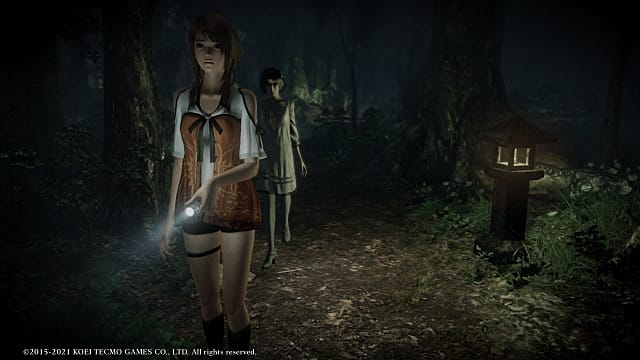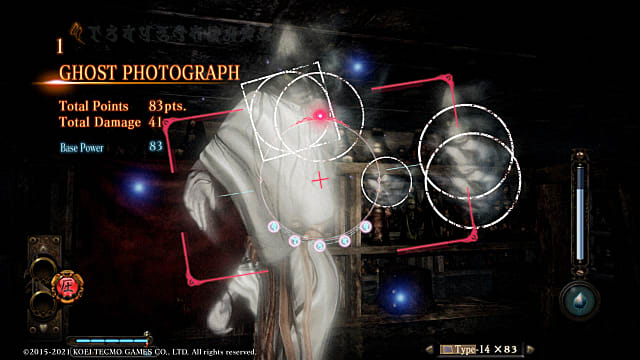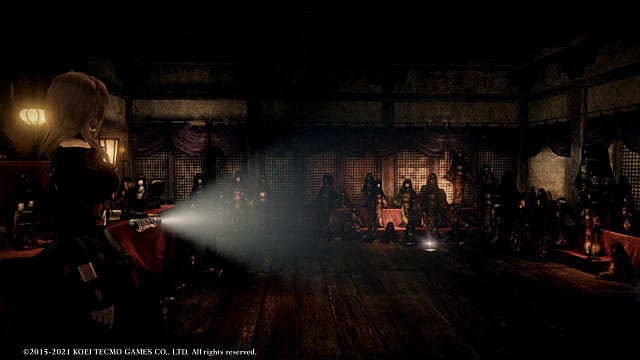For 20 years, Fatal Frame has been something of an outlying series in the J-Horror gaming world. It is distinctly different from Resident Evil, Silent Hill, and other mainstays of the PlayStation 2-era. Its focus on slower-paced exploration through spooky haunted places with only an antique camera as protection from angry spirits still feels unique.
Fatal Frame Maiden of Blackwater isn’t the first outing for the restless maiden spirits hinted at in the title; this survival horror game was originally released in 2015 on the Wii U, though it’s probably still a new experience for most. While there are enhancements in the visuals, resolution, and other areas with this new release, Fatal Frame still looks and feels very much like its predecessors.
Fatal Frame Maiden of Black Water Review: The Return of Creepy Photographic Horror
The series, as a whole, hasn’t been seen in a long while for those of us in the West. Prior to Maiden of Black Water, no Fatal Frame games have been released here since 2005. So, there’s a whole generation that conceivably hasn’t heard of the series at all. And this makes it a perfect time to jump in.
Intertwining the stories of three different characters, Maiden of Black Water is centered around the dark forests, waters, caves, rocky paths, and shrines of Mt. Hikami, Japan. Once a revered spot, a violent twist in its history has turned the place into the stuff of nightmares. Mt. Hikami is haunted by countless suicides, gruesome murders, and people who just go missing.
Much of the game centers on Yuri Kozukata, a young woman gifted (or cursed) with exceptionally strong sensitivities to the supernatural world. She finds herself drawn into a mystery involving missing girls.
Ren Hojo’s story mixes heavily in Yuri’s. He’s a man driven to find the source of bizarre nightmares. The third character, a young woman named Miu, comes into the story later, but all of them inevitably end up taking the same paths to unravel the mysteries and horrors of the mountain.

While there are some minor differences between the three characters in terms of controls and abilities, Maiden of Blackwater largely plays the same no matter what character or chapter you’re in. Its third-person exploration across maze-like maps takes you through a variety of indoor and outdoor locations. Things to investigate and items to pick up are all over the place, but so are dangers.
Those dangers are, inevitably, of the supernatural sort. Fatal Frame is fixated on ghosts as opposed to the physical dangers of zombies and vampires, and the only way to combat these spirits is with the Camera Obscura. This antique camera lets you suck up a ghost’s energy with well-placed shots. It also lets you see otherwise invisible things.
There are times when the camera is used to focus on a certain spot to reveal hidden objects, which is simple enough. Other tasks require you find a spot shown in a photo and recreate the shot. These puzzles can be irksome and frustrating, since finding the exact sweet spot can be an annoying bout of trial and error that feels almost random.
The camera combat is terrific, though. You’ll find an array of film types that have different reloading speeds and damage modifiers, in addition to actual add-ons for the camera that let you do extra damage among other perks. Whenever you take a shot of a ghost, its face highlighted, you’ll do damage and that damage, in turn, will force the ghost to lose more spirit energy.
This energy floats around the ghost, and the more energy you can capture in a shot, the more damage you’ll inflict. Do enough damage and the ghost will be exorcised. Of course, the ghosts aren’t taking this lying down. They’ll try to charge, attack, and drag you down into the abyss. Thankfully, there is a dodge ability and overall, on normal difficulty level, Fatal Frame is more about creating an intense atmosphere than killing you.

That atmosphere is, despite the age of the game, amazingly thick. Fatal Frame’s story manages to throw in nearly every J-Horror trope you can think of. There’s the suicide forest, creepy ghost children, even creepier haunted dolls, angry shrine maiden ghosts who apparently float through the afterlife wearing sheer white gowns with plummeting V-necks that barely contain their ghostly assets.
Two of the main characters fall squarely into the Japanese schoolgirl camp, complete with highly questionable fashion choices given the situation they’re in and a focus on getting their clothing soaked. It would be pretty easy to pick out questionably sexist story elements here as well, but the overall effect is a game that does a great job of creating a hell of a horror-movie ride.
Being cinematic is a huge part of Fatal Frame’s appeal. It loves to use film and home video filters to terrific effect. Memories are seen through grainy VHS-like sequences. The color schemes have a lovely old-time photography bent and the interplay of light and dark throughout makes everything beautifully eerie and unnerving.
The ghosts look fantastic. Eerie visages in mostly black and white that flow through the air and architecture with menacing and often tragic intent. There are a variety of spirits to encounter, not all of them violent, and capturing their final moments on film can be surprisingly poignant and intense.

The overall soundtrack is great too, with an excellent score and terrific ambient effects that amp up the creep factor. The voice acting and dialogue are solid as well. The story itself is frequently relayed through found journals and books and while the writing overall is sparse, it helps create a fascinating and grim back story.
The controls are somewhere in between the old-style tank controls of the original Resident Evil and more modern third-person games. As a result, there are some oddities. Interacting with things can be clumsy since the camera has a tendency to spastically flip around the character. Running and following are weird too.
At times, you’ll have to hold one button to see and follow a spirit and you just automatically walk the path while the button is held down. Running also causes the character to be on some halfway auto-pilot and feels especially clumsy. During both actions, it’s simply clunky to turn, stop, or look at anything else.
Objects of interest are highlighted with either white or red (for threats) arrows on the sides of the screen, which theoretically point in the direction of something. They’re unreliable and erratic markers though, leading to particular confusion when trying to track the teleporting ghostly entities.
Fatal Frame: Maiden of Black Water Review — The Bottom Line
Pros
- Amazing horror atmosphere thanks to beautiful use of cinematography, film and video filter effects, and beautifully-rendered ghosts
- Photography-centered gameplay and combat still feel unique and engaging
- Excellent overall story that throws in a myriad of J-Horror movie tropes effectively
Cons
- Photo recreation puzzles are especially cumbersome
- Controls and camera can be clumsy
- Some real questionable fashion choices (and associated camera angles and cliches) for the women characters
Fatal Frame: Maiden of Black Water is a welcome return of an obscure, yet memorable PS2-era series. This revamp of the Wii U version still feels firmly rooted in the past, but it makes such superb use of atmospheric visual and audio effects that the overall experience is a unique take on horror games. It’s well worth giving this remake a second chance.
[Note: Koei Tecmo provided the copy of Fatal Frame Maiden of Blackwater used for this review.]






Published: Oct 31, 2021 08:35 pm